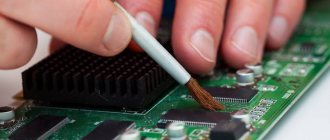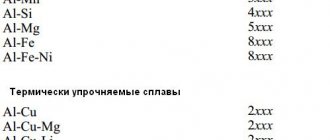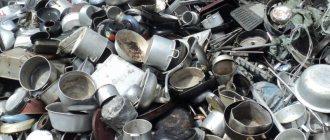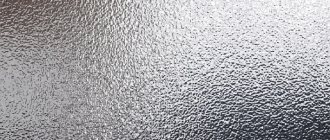Fluxes for aluminum
Soldering aluminum is a rather complex technological process. In addition to the oxide film on the surface of aluminum, the process is complicated by the need to expose it to higher temperatures than when soldering copper. However, aluminum can be soldered because special fluxes have been developed for this purpose.
The main task of flux for low-temperature soldering of aluminum is to dissolve the oxide film, which interferes with the normal spreading of solder and joining of parts. For soldering aluminum, only active fluxes containing acid are used. Rosin and other similar inactive fluxes are absolutely not suitable for these purposes.
Flux composition for aluminum
The main components of active fluxes for soldering aluminum at temperatures below 300 degrees are organic acids and their amides, as well as triethanolamine. The most active acids are oleic, elaidic, formic and acetic acid.
This is due to the fact that the activity of all of the above acids increases with increasing temperature. Therefore, by acting on Al2O3 oxide, they are able to completely destroy it, which will allow the solder to adhere normally to the surface of the aluminum parts being soldered.
Soldering flux 34-A
Activity temperature range: 420 – 620°C (no specifications in the specifications)
For solders: medium-melting solders based on aluminum alloys with silicon and zinc, such as solder 34-A (no specifications in the specifications)
For materials: aluminum and its alloys (not containing more than 1.5% magnesium - there are no characteristics in the specifications)
Physical state: powder
Application methods: pour flux powder, dip into a flux solution in water
Heating methods for soldering: torch flame, oven
Solvents: water
Removing flux residues: washing with hot water
Composition: NaF - 10±1%, LiCl - 32±3%, ZnCl2 - 8±2%, KCl - 50±3%
Complies with TU 48-4-229-87
Flux can be applied in various ways, each having its own advantages and disadvantages. It is necessary to take into account the extreme hygroscopicity of the flux, its tendency to form lumps in the presence of moisture and “spread” when exposed to open air.
It is convenient to slightly warm up small parts and sprinkle them with flux (dip them into the flux), taking advantage of the effect of the flux “sticking” to the heated surface. Wet flux will not stick to a heated surface.
You can sprinkle parts covered with a film of water with flux (dip them in flux) to achieve “sticking”. The prepared surfaces of parts for soldering should be well wetted with water.
Less commonly, in mass production (with a hint of mechanization), they use flux mixing in water and then applying it to the parts by dipping. All flux components are insoluble in water and are suspended in solution. The flux must be constantly stirred to ensure uniform distribution of the components throughout the volume. Dilution must be done extremely carefully, adding flux in small portions and mixing thoroughly. Dissolution occurs with extreme heating! The solution may boil and cause burns!!! It is necessary to wait until the mixture cools before adding flux again. The solution is not intended for long-term storage.
All the described methods are not universal and are designed for highly qualified and experienced soldering workers.
Suitable for soldering in furnaces and torches, except oxygen-acetylene ones due to reduced flux activity.
Soldering aluminum has many difficulties associated with the pronounced characteristics of this metal. An extremely chemically active metal that has a mechanically and chemically resistant film of aluminum oxide in the air, protecting it from chemical interactions with surrounding substances. At the same time, it has high thermal conductivity.
When performing flux soldering, it is necessary to remove the persistent oxide film and protect the surface from oxidation. This is achieved by the fact that the flux (flux 34-A) when heated destroys and dissolves aluminum oxide, while metallic zinc is deposited on the surface, which, together with the flux coating, protects the aluminum. Therefore, when soldering, you need to carefully monitor the integrity of the flux coating.
To ensure uniform spreading of solder, it is necessary to ensure uniform heating in the soldering area. It is necessary to take into account the large heat dissipation from the soldering zone through aluminum parts. Solder spreads better in the direction of increasing heat; this must be taken into account to obtain a fillet transition of solder between parts. Therefore, when heated with a gas burner, the flame should “wash” the soldering zone and some part of the parts adjacent to it. It is necessary to use the middle part of the flame, which has reducing or neutral properties, in contrast to the final oxidizing part, which has a higher temperature. An oxidizing flame can dramatically reduce flux activity! To compensate for the uneven heating of parts being soldered that differ in thickness and weight, the burner flame must be shifted towards a more massive part. When overheated and heated for a long time, aluminum strongly dissolves in the solder, which leads to poor-quality soldering.
The surface of the parts to be soldered must be degreased. “Light” solvents such as acetone give good results. If the surface has not been mechanically treated, it must be etched to remove most of the oxide film in appropriate solutions.
Flux residues are removed by boiling in water or washing with hot water and wiping with a hair brush.
Flux brands for aluminum soldering
Flux F59A - intended for low-temperature soldering of aluminum, as well as AMts alloy with copper and steel, at temperatures from 150 to 320 degrees.
Flux F61A - in addition to soldering aluminum, it is intended for soldering parts made of galvanized iron, copper and beryllium bronze. The temperature for working with flux, as in the previous case, is 150-320°C.
Flux F54A - consists of 82% triethanolamine. This flux is also intended for soldering aluminum and its alloys at home.
Flux F64 - suitable for soldering aluminum and duralumin.
This version of the flux for aluminum is somewhat reminiscent of the LTI-120 soldering flux, which is intended for soldering copper, nickel and carbon steel. When F-64 flux is applied to the surface of aluminum parts, and under the influence of high temperatures, it is able to destroy the durable film of aluminum oxide, thereby cleaning the metal for normal spreading of solder.
All of the above fluxes are suitable for soldering aluminum. Well, you can always find out how to solder wires on the website.
Hardwired
Purpose of flux
| Brand | Appearance | Solderable metal or metal coating | Solders used | Purpose |
| Rosin grade A | Copper; silver, tin, zinc, tin-lead, tin-bismuth, gold coatings | Tin-lead, tin-lead-cadmium (at soldering temperatures above 220°C), silver PSr1.5 and PSr2 | Manual and mechanized soldering and tinning of mounting elements and other surfaces. Preservation of the product to preserve solderability under warehouse storage conditions. | |
| FKSp (FKEt) | Light brown liquid | Same | Same | The same, as well as soldering of conductors with insulation in the form of tubes or enamel insulation, products with increased requirements for insulation resistance |
| FCDT | Dark brown liquid | Copper; silver, tin, tin-lead, tin-bismuth, gold coatings | Tin-cadmium-indium, tin-lead, tin-lead-bismuth, tin-lead-cadmium, indium | Manual and mechanized soldering and tinning of mounting elements and other surfaces. |
| LTI-120 | Dark brown liquid with slight sediment | Carbon steel, copper and its alloys, nickel and its alloys; tin, silver, cadmium, zinc, tin-lead, tin-bismuth coatings | Tin-lead, silver PSr1.5 and PSr2 | Manual and mechanized soldering and tinning of mounting elements that do not have insulation in the form of tubes on the terminals, and other surfaces in widely used products. |
| FGSp, FSkSp, FSkPs | FGSp, FSkSp – colorless liquid; FSkPs – homogeneous paste of light yellow color | Copper and its alloys, nickel and its alloys; tin, silver, cadmium, zinc, tin-lead, tin-bismuth coatings | Tin-lead, tin-lead-bismuth, tin-lead-cadmium | Manual (FSkPs and FSkSp) and mechanized soldering and tinning of mounting elements that do not have insulation on the terminals in the form of tubes and other metal surfaces in widely used products |
| FCS | Yellow liquid | Copper; tin, silver, cadmium, zinc, tin-lead, tin-bismuth coatings | Tin-lead, tin-lead-bismuth, tin-lead-cadmium | Manual and mechanized soldering and tinning of mounting elements and other metal surfaces in consumer products |
| FDGL | Colorless thick liquid. At soldering temperature – brown | Same | Tin-lead | Manual and mechanized soldering and tinning of consumer products. Group soldering by immersion in soldering flux at a temperature of 220–250°C and melting of electrolytically tin-coated parts before soldering |
| FCA | Colorless liquid | Copper and its alloys (including BrB), carbon and stainless steels, nickel and its alloys | Tin-lead and low temperature silver | Pre-tinning (mechanized and manual) and soldering of products, subject to complete removal (using neutralizing solutions) of flux residues after soldering, except for mounting connections |
| FDFs | Colorless liquid | Steel, chromium-nickel alloys (nichrome, permalloy, superinvar, kovar, invar), copper and its alloys | Tin-lead | Manual and mechanized soldering and tinning of products, except for mounting connections |
| ZhZ-1-AP, ZhZ-2-AP | Viscous dark brown liquid | Tin-lead | Protection of the molten solder surface from oxidation in mechanized soldering installations | |
| 284, 209 | White powder | Copper and its alloys, stainless and structural steels, heat-resistant alloys | Silver | Soldering of electronic components and various structures using gas-flame heating and in furnaces |
| 200 | White powder | Stainless and structural steels, heat-resistant alloys | Brass and solders with a melting point of 850–1000°C | Soldering of electronic components and various structures using gas-flame heating and in furnaces |
| 34A, F370A | White powder | Aluminum and its alloys, except alloys with magnesium content above 3% | Aluminum | Soldering of electronic components |
| 16VK | Aluminum and its alloys | Aluminum | Soldering of electronic components. Group soldering of components by immersion in a salt bath |
Flux composition. Removing flux residues
| Brand | Composition (weight) | Removing flux residues after soldering | |
| Component | % | ||
| FKSp (FKEt) | Pine rosin | 10 – 60 | Ethyl alcohol or alcohol-gasoline mixture 1:1 |
| Ethyl alcohol or ethyl acetate | 90 – 40 | ||
| FCDT | Pine rosin | 10 – 20 | |
| Dimethylalkylbenzyl ammonium chloride (kitamine AB) | 0,1 – 3,0 | ||
| Tributyl phosphate | 0,01 – 0,10 | ||
| Ethyl alcohol or ethyl acetate | 89,89 – 76,90 | ||
| LTI-120 | Pine rosin | 20 – 25 | |
| Diethylamine hydrochloride | 3 – 5 | ||
| Triethanolamine | 1 – 2 | ||
| Ethanol | 76 – 68 | ||
| FGSSp | Hydrazine hydrochloride | 2 – 4 | Hot running water (70±10°C) or alcohol-gasoline mixture 1:1 |
| Ethylene glycol or glycerin | 25 – 50 | ||
| Ethanol | 73 – 46 | ||
| FSkSp | Semicarbazide hydrochloride | 2 – 4 | |
| Ethylene glycol or glycerin | 25 – 50 | ||
| Ethanol | 73 – 46 | ||
| FSkPs | Semicarbazide hydrochloride | 3 – 5 | |
| Glycerol | 70 – 58 | ||
| Polyox-100 or Polyox-115 | 27 – 37 | ||
| FCS | Salicylic acid | 4,0 – 4,5 | Alcohol-gasoline mixture 1:1 |
| Triethanolamine | 1,0 – 1,5 | ||
| Ethanol | 95 – 94 | ||
| FDGL | Diethylamine hydrochloride | 4 – 6 | Hot running water (70±10°C) |
| Glycerol | 96 – 94 | ||
| FCA | Zinc chloride | 45,5 | Hot running water (70±10°C) and neutralizing reagents |
| Ammonium chloride | 9 | ||
| Water | 45,5 | ||
| Zinc oxide hydrate | Before precipitation occurs | ||
| FDFs | Diethylamine hydrochloride | 20 – 25 | Hot running water (70±10°C) or alcohol-gasoline mixture 1:1 |
| Ethylene glycol | 60 – 50 | ||
| Phosphoric acid (specific gravity 1.7) | 20 – 25 | ||
| ZhZ-1-AP | Cylinder oil “52” or “KS-19” | 79 – 81 | Alcohol-gasoline mixture 1:1, trichlorethylene, acetone |
| Organosilicon liquid PFMS-6 | 16 – 17 | ||
| Oleic acid | 4,9 – 1,8 | ||
| Antioxidant NG-2246 | 0,1 – 0,2 | ||
| ZhZ-2-AP | Cylinder oil “52” or “KS-19” | 58,52 – 69,75 | |
| Organosilicon liquid PFMS-6 | 21,65 – 10,66 | ||
| Cottonseed oil | 11,0 – 10,64 | ||
| Oleic acid | 8,79 – 9,02 | ||
| Antioxidant NG-2246 | 0,04 – 0,03 | ||
| 284 | Boric anhydride | 23 – 27 | Hot running water (70±10°C) and cold running water |
| Potassium fluoride | 33 – 37 | ||
| Potassium borofluoride-hydrogen | 44 – 36 | ||
| 209 | Boric anhydride | 33 – 37 | |
| Potassium fluoride | 40 – 44 | ||
| Potassium borofluoride-hydrogen | 27 – 19 | ||
| 200 | Boric anhydride | 70 – 62 | Hot flow and neutralizing reagents |
| Sodium tetraborate (borax) | 17 – 21 | ||
| Calcium fluoride | 13 – 17 | ||
| 34A | Potassium chloride | 56 – 44 | |
| Lithium chloride | 29 – 35 | ||
| Zinc chloride | 6 – 10 | ||
| Sodium fluoride | 9 – 11 | ||
| F370A | Potassium chloride | 51 – 46 | |
| Lithium chloride | 36 – 39 | ||
| Sodium fluoride | 4 – 5 | ||
| Cadmium chloride | 9 – 10 | ||
| 16VK | Sodium chloride | 12 | |
| Potassium chloride | 44 | ||
| Lithium chloride | 34 | ||
| Eutectic (aluminum fluoride – 54%, potassium fluoride – 46%) | 10 | ||
Table 3 influence of flux residues on insulation and their corrosive effect
| Brand | Effect of flux residues on insulation resistance | Corrosive effect of flux residues | |||
| for copper | for silver plating | on tin-lead coating | for nickel coating | ||
| FKSp (FKEt), FKDT | do not affect | do not provide | |||
| LTI-120, FGSp, FSkSp | reduce | provide | do not provide | ||
| FSkPs | reduce | provide | do not provide | provide | do not provide |
| FCS | reduce | have a weak | do not provide | ||
| FDGL | reduce | provide | have a weak | do not provide | n/a |
| FDFs | reduce | provide | do not provide | do not provide | provide |
| FCA | reduce | provide | |||
| ZhZ-1-AP, ZhZ-2-AP | do not affect | do not provide | — | ||
When soldering copper conductors, as well as grounding conductors to the armor and lead sheath of cables, use solder paste of the following composition (in weight parts):
- Rosin…………………………………….. 10;
- Animal fat………………………………. 3;
- Ammonium chloride ………………………… 2;
- Zinc chloride…………………………….. 1;
- Water or rectified ethyl alcohol.. 1.
For the same purposes, the following composition is often used for solder paste:
- Rosin……………………………………… 2.5%;
- Salo ……………………………………………. 5 %;
- Zinc chloride……………………………20%;
- Ammonium chloride …………………………. 2%;
- Technical Vaseline……………………… 65.5%;
- Distilled water………………….. 5%.
Flux for soldering aluminum
| Brand | Compound, % | Melting point, °C | |||||
| Potassium chloride | Sodium chloride | Lithium chloride | Sodium fluoride | Cryolite grade K-1 | Magnesium chloride | ||
| YOU | 50–55 | 30–35 | — | — | 10–20 | — | 630 |
| AF-4A | 50 | 28 | 14 | 8 | — | — | » 600 |
| HP | 50 | — | 30 | — | — | 20 | |
VAMI flux is used for terminating wire and cable cores, AF-4A flux is used only for connecting cable cores in couplings.
Fluxes for soldering with soft and semi-hard solders according to electrical standards 0AA.614.017-67 and 0AA.614.028-68
| Brand | Purpose | Compound | Cleaning after soldering | |
| Component | % | |||
| TO | Tinning and soldering of current-carrying parts made of copper and its alloys | Pine rosin | 100 | Not required |
| KSP | Tinning and soldering of current-carrying parts made of copper and its alloys | Pine rosin | 25 | Not required |
| Technical ethyl alcohol grade B | 75 | |||
| FPP | Tinning and soldering of current-carrying parts made of copper and its alloys | Polyester resin grade PA9 | 20–30 | Not required |
| Methyl ethyl ketone or ethyl acetate | 80–70 | |||
| STUZO-12224-61 | Tinning and soldering of current-carrying parts made of copper, nickel and their alloys and parts coated with copper, tin, cadmium, silver and zinc | Pine rosin | 20–35 | Swab or brush soaked in solvent or alcohol |
| Diethylamine hydrochloride | 3–5 | |||
| Triethanolamine | 1–2 | |||
| Technical ethyl alcohol grade B | 76–68 | |||
| F59A 0AA.614.017-67 | Tinning and soldering of aluminum and AMts alloy with each other and with copper and its alloys | Cadmium borofluoride | 10 | Running hot water or alcohol |
| Zinc borofluoride | 3 | |||
| Ammonium borofluoride | 5 | |||
| Triethanolamine | 82 | |||
| 34A 0AA.614.017-67 | Soldering of aluminum and its alloys (melting point 420 °C) | Cadmium fluoride | 50±6 | Hot, then cold running water |
| Lithium chloride | 32±6 | |||
| Zinc chloride | 8±2 | |||
| Sodium fluoride | 10±1 | |||
| LM1 | Tinning and soldering of iron-nickel alloys and stainless steels | Pine rosin | 20–35 | Swab or brush soaked in solvent or alcohol |
| Diethylamine hydrochloride | 3–5 | |||
| Triethanolamine | 1–2 | |||
| Technical ethyl alcohol grade B | 76–78 | |||
| F38N | Tinning and soldering nichrome between itself and copper | Diethylamine hydrochloride | 25–30 | Hot water or a brush dipped in alcohol |
| Ethylene glycol | 60–50 | |||
| Phosphoric acid | 29–25 | |||










